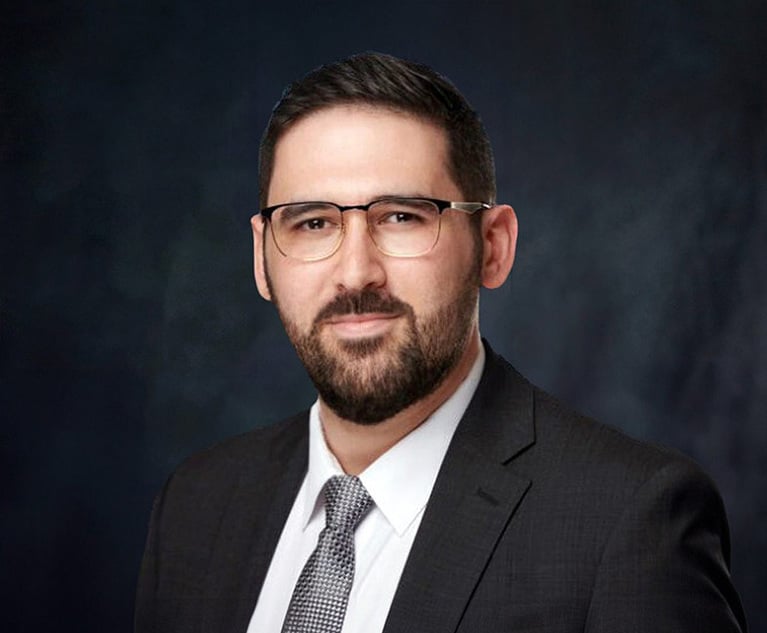6 Questions on the Power—and Limits—of Litigation Communications
Your firm is representing a client involved in a high-profile lawsuit. You know the matter is locally, regionally, even nationally newsworthy. Whether the plaintiff or respondent or defendant, your client has a story to tell or a message to share.
May 31, 2019 at 12:56 PM
5 minute read
 Julie Talenfeld of BoardRoom PR.
Julie Talenfeld of BoardRoom PR.Your firm is representing a client involved in a high-profile lawsuit. You know the matter is locally, regionally, even nationally newsworthy. Whether the plaintiff or respondent or defendant, your client has a story to tell or a message to share.
Whether you're first out of the gate with a media message, or responding to opposing counsel's public statements, your message or response can be critical to ensuring your side is heard. This can be especially true for matters being tried in court, and the court of public opinion.
Sharing them appropriately, tastefully and within the bounds of the state bar association regulations can ensure your message is embraced by recipients and not thwarted by regulatory powers.
Litigation communications can be critical to any law firm's marketing program. Along with advertising, blogging and marketing communications, media relations can be central to getting the firm's message out to journalists and their readers.
What is the appropriate and allowable venue for your firm to share your client's message or response to opposing counsel's comments?
Some abhor the concept of “trying their case in the media.” To be sure, there are appropriate and inappropriate, even improper, times to take your story public. Sometimes, however, it's unavoidable or “just happens” if the media learns of your matter and inquires, thus forcing a response.
How can your firm effectively and appropriately execute on litigation communications? Media relations often is the solution. This highly specialized and sensitive niche within the greater scope of marketing communications can be effective in driving firm, client, or litigation-specific messaging.
Consider these six questions when establishing a communications plan designed for specific litigation:
- Should you seek any media at all?
This question opens up a decision tree. If you and your client determine no media coverage should be sought, reporter questions should receive a “No comment,” or if the judge has issued a gag order, then your decision is simple. If you decide to pursue or respond to the media, continue on. As a caveat, once a case has been brought to conclusion and any embargos or gag orders have been lifted, the following questions should be considered.
- Who will be the case's voice?
If your case is likely to find media interest, decide early on who should be the spokesperson. The lead attorney can be the voice of the case, even if the client is occasionally made available as the “face” that personalizes the case. But making this decision early can clarify your approach.
- Should you proactively seek media exposure?
Whether at the start or completion of a case, high-profile matters command attention. Imagine a class-action lawsuit in an issue that's been widely covered, or a celebrity or well-known individual is involved in a public entanglement, or a unique, “man bites dog” story in which the public and media are interested. Similarly with multimillion dollar settlements or verdicts, precedent-setting rulings, or other noteworthy outcomes, they may command attention. Anticipate that as counsel in the case, a reporter's call will come. Prepare a press release or speaking points to help tell your client's story.
- What if the media calls unsolicited? Do we take the call?
When a reporter calls in response to a press release, your media relations effort has been a success. But what if a reporter calls about your case unsolicited? Make sure the spokesperson is the only person to whom the receptionist steers the call. Relevant talking points should be decided in advance; adhere to how much—or little—you decide to discuss.
- How can you control the story?
“Getting in front of the coverage” is an important strategy for certain public matters. From issuing statements and press releases, to staging news conferences to gather the media in one location to present your client's case, the first to speak often sets the dialogue. It may be smart to beat opposing counsel to the microphone.
- Should you hire a litigation communications firm?
After asking yourself these questions, would you be best served to hire a media relations team that specializes in legal services? You can focus on the case; the media relations firm can focus on message delivery.
Finally, keep in mind the court and Florida Bar rules may affect your litigation communications strategy. If the trial judge warned against or placed a gag order on trial or proceedings, this will guide your outreach or response.
Additionally, legal services advertising, marketing and communication must comply to rules under Florida Bar Subchapter 4-7. More directly, Florida Bar Rule 4-7.11 states that lawyers are not required to file for review any press release “if the press release is provided solely to legitimate media outlets where the media outlets have complete editorial control, including whether to print any information in the press release, and where the media outlet is not paid to print information from the press release.”
Effective litigation communications can ensure you and your client control the message told to the media, the marketplace and possibly the court of public opinion.
Julie Talenfeld is the president of BoardroomPR, one of Florida's premier litigation communications agencies. She can be reached at [email protected]
This content has been archived. It is available through our partners, LexisNexis® and Bloomberg Law.
To view this content, please continue to their sites.
Not a Lexis Subscriber?
Subscribe Now
Not a Bloomberg Law Subscriber?
Subscribe Now
NOT FOR REPRINT
© 2025 ALM Global, LLC, All Rights Reserved. Request academic re-use from www.copyright.com. All other uses, submit a request to [email protected]. For more information visit Asset & Logo Licensing.
You Might Like
View All
Conversation Catalyst: Transforming Professional Advancement Through Strategic Dialogue
5 minute read
SEC Whistleblower Program: What to Expect Under the Trump Administration
6 minute read
Turning the Shock of a January Marital Split Into Effective Strategies for Your Well-Being
5 minute read
Trending Stories
- 1States Accuse Trump of Thwarting Court's Funding Restoration Order
- 2Microsoft Becomes Latest Tech Company to Face Claims of Stealing Marketing Commissions From Influencers
- 3Coral Gables Attorney Busted for Stalking Lawyer
- 4Trump's DOJ Delays Releasing Jan. 6 FBI Agents List Under Consent Order
- 5Securities Report Says That 2024 Settlements Passed a Total of $5.2B
Who Got The Work
J. Brugh Lower of Gibbons has entered an appearance for industrial equipment supplier Devco Corporation in a pending trademark infringement lawsuit. The suit, accusing the defendant of selling knock-off Graco products, was filed Dec. 18 in New Jersey District Court by Rivkin Radler on behalf of Graco Inc. and Graco Minnesota. The case, assigned to U.S. District Judge Zahid N. Quraishi, is 3:24-cv-11294, Graco Inc. et al v. Devco Corporation.
Who Got The Work
Rebecca Maller-Stein and Kent A. Yalowitz of Arnold & Porter Kaye Scholer have entered their appearances for Hanaco Venture Capital and its executives, Lior Prosor and David Frankel, in a pending securities lawsuit. The action, filed on Dec. 24 in New York Southern District Court by Zell, Aron & Co. on behalf of Goldeneye Advisors, accuses the defendants of negligently and fraudulently managing the plaintiff's $1 million investment. The case, assigned to U.S. District Judge Vernon S. Broderick, is 1:24-cv-09918, Goldeneye Advisors, LLC v. Hanaco Venture Capital, Ltd. et al.
Who Got The Work
Attorneys from A&O Shearman has stepped in as defense counsel for Toronto-Dominion Bank and other defendants in a pending securities class action. The suit, filed Dec. 11 in New York Southern District Court by Bleichmar Fonti & Auld, accuses the defendants of concealing the bank's 'pervasive' deficiencies in regards to its compliance with the Bank Secrecy Act and the quality of its anti-money laundering controls. The case, assigned to U.S. District Judge Arun Subramanian, is 1:24-cv-09445, Gonzalez v. The Toronto-Dominion Bank et al.
Who Got The Work
Crown Castle International, a Pennsylvania company providing shared communications infrastructure, has turned to Luke D. Wolf of Gordon Rees Scully Mansukhani to fend off a pending breach-of-contract lawsuit. The court action, filed Nov. 25 in Michigan Eastern District Court by Hooper Hathaway PC on behalf of The Town Residences LLC, accuses Crown Castle of failing to transfer approximately $30,000 in utility payments from T-Mobile in breach of a roof-top lease and assignment agreement. The case, assigned to U.S. District Judge Susan K. Declercq, is 2:24-cv-13131, The Town Residences LLC v. T-Mobile US, Inc. et al.
Who Got The Work
Wilfred P. Coronato and Daniel M. Schwartz of McCarter & English have stepped in as defense counsel to Electrolux Home Products Inc. in a pending product liability lawsuit. The court action, filed Nov. 26 in New York Eastern District Court by Poulos Lopiccolo PC and Nagel Rice LLP on behalf of David Stern, alleges that the defendant's refrigerators’ drawers and shelving repeatedly break and fall apart within months after purchase. The case, assigned to U.S. District Judge Joan M. Azrack, is 2:24-cv-08204, Stern v. Electrolux Home Products, Inc.
Featured Firms
Law Offices of Gary Martin Hays & Associates, P.C.
(470) 294-1674
Law Offices of Mark E. Salomone
(857) 444-6468
Smith & Hassler
(713) 739-1250






